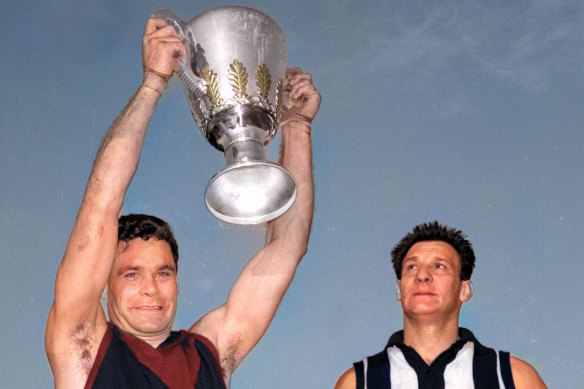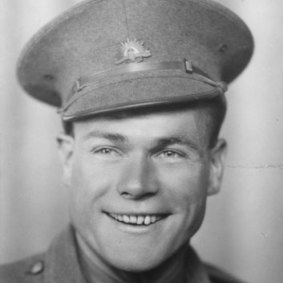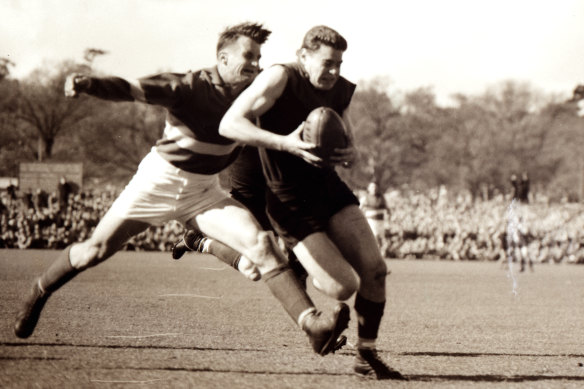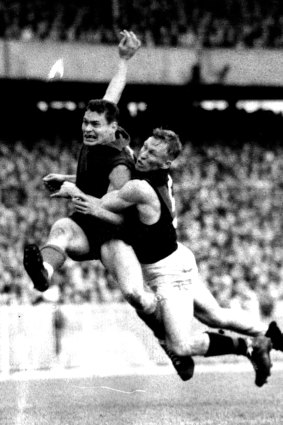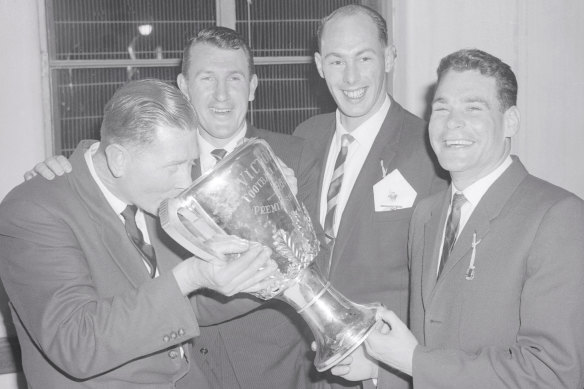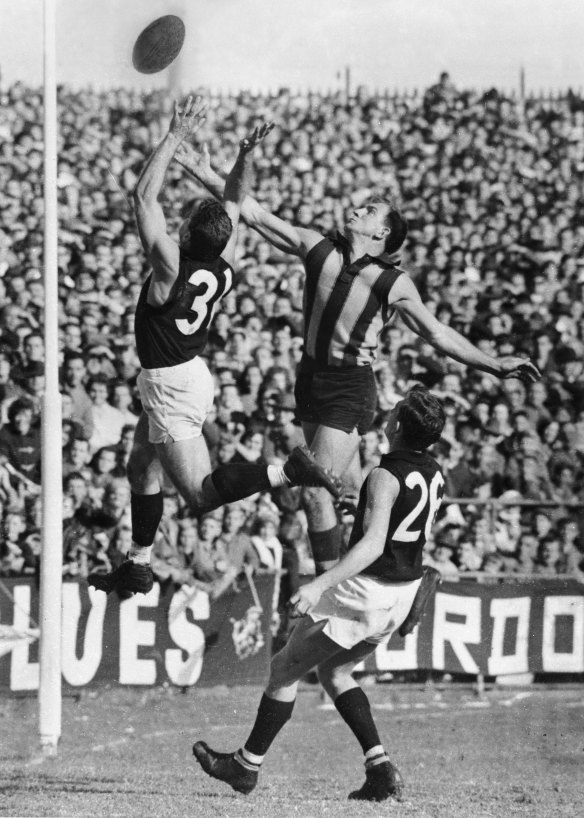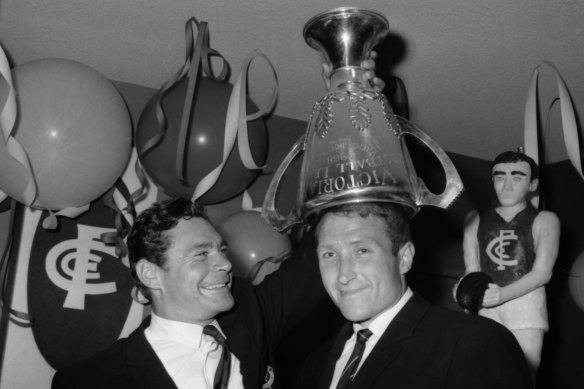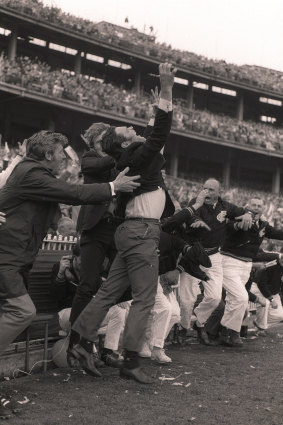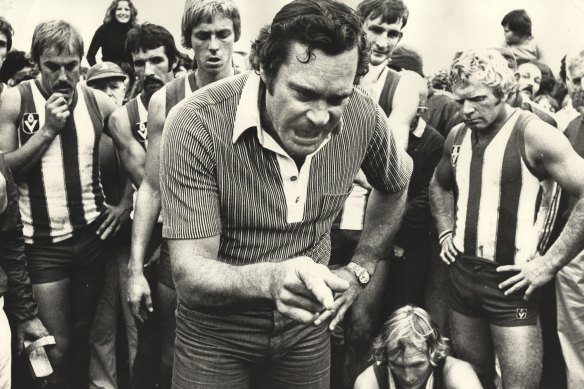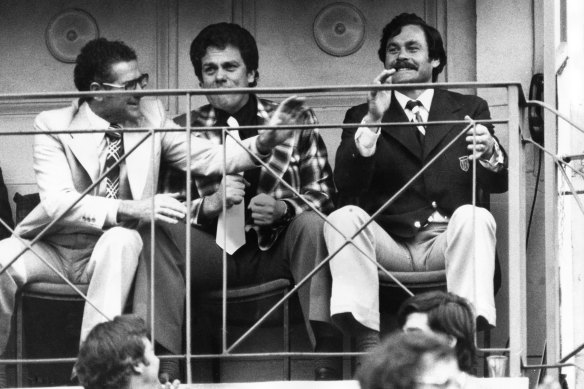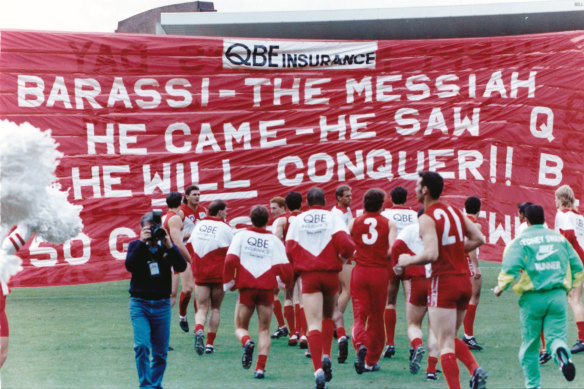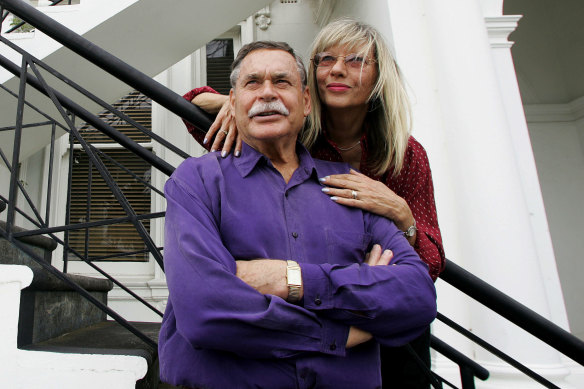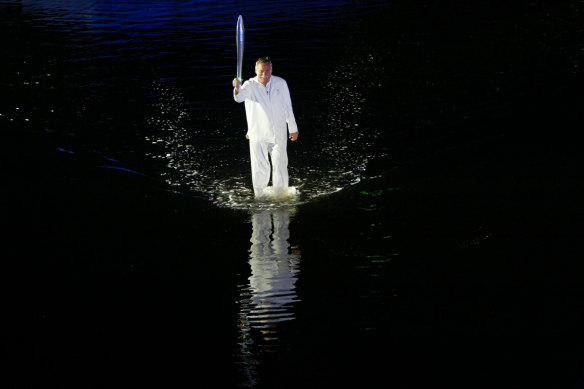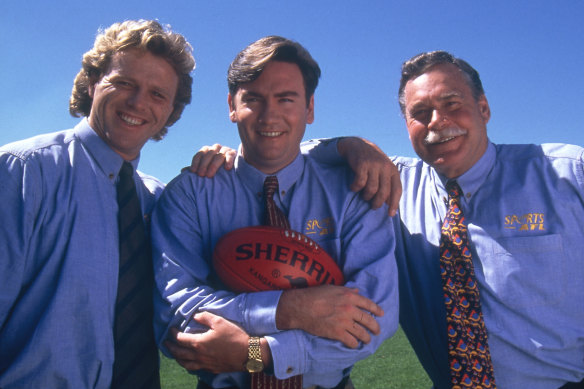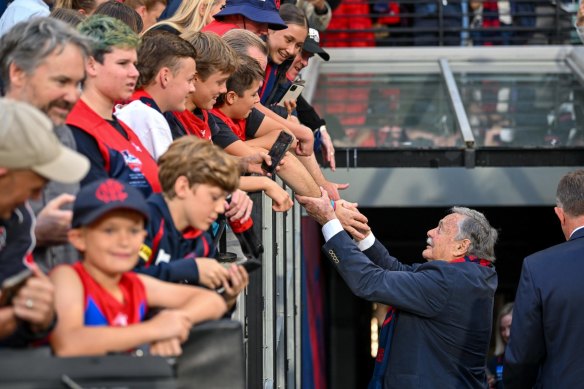Save articles for later
Add articles to your saved list and come back to them any time.
Ron Barassi: February 27, 1936, to September 16, 2023.
It’s as simple as this. Ron Barassi, who died on Saturday aged 87 from complications after a fall, was the single biggest figure in post-war Australian rules football history.
Melbourne captain Ron Barassi holds up the 1964 VFL premiership cup as Collingwood captain Ray Gabelich looks on.Credit: The Age
Player, captain, coach, media performer, ambassador and prophet: there was no aspect of the game in which he did not excel. He was the linchpin of Melbourne’s prodigious run of mid-century premierships; no team has won more in a shorter span.
As coach, he conjured up impossible victory for Carlton in the 1970 grand final, arguably still the most famous of all. He guided North Melbourne to its first premiership, and another via a rare drawn grand final.
He is in the AFL’s team of the century, was the first legend inducted into the AFL’s Hall of Fame, is in the Sport Australia Hall of Fame, has a statue in his honour at the MCG and an imaginary line in his name, coined by Professor Ian Turner in 1978 to describe where footy codes divide in Australia.
All this is true, and yet it still does not nearly convey the ubiquity and immensity of his presence in Melbourne and in the game during his heyday and for many years afterwards. His handsome mustachioed visage was the face of the game.
Barassi was born to Ron snr, scion of Swiss-Italian immigrants, and Elza at Castlemaine in 1936. Ron snr played in Melbourne’s 1940 premiership, but died the next year at Tobruk, when he was just 27 and his son five. His loss remained an ache for Ron jnr all his life.
Barassi grew up in Guildford, startling primary schoolmates with his aptitude at marbles, before proceeding to Castlemaine Tech, then Preston and Footscray techs in Melbourne.
Melbourne Football Club kept vigil over him, promising his mother whatever help she needed, and forced through an early version of the father-son rule to rescue young Barassi from the clutches of Carlton and Collingwood, to whom he was zoned.
Ron Barassi snr died at Tobruk.Credit: Australian War Memorial
When his mother remarried and moved to Tasmania, she paid for a bungalow for her 16-year-old son behind the Pascoe Vale home of Norm Smith, Ron snr’s old teammate and by then the Demons’ coach. So began one of the game’s most famous mentor-mentee relationships.
In the manner of the times, there was no mollycoddling. Frank “Bluey” Adams, Barassi’s long-time teammate, thought Smith in his need not to be seen to play favourites was hard on his protege to the point of being “grossly unfair”. “I have no doubt it made Ron mentally tougher,” he said.
Barassi’s football began at Preston Scouts in the Preston District Junior Football Association. At Melbourne, he started in the thirds before making his senior debut aged just 17 in 1953 and was greeted by an unceremonious shirtfront from Footscray’s Charlie Sutton.
Melbourne ran second-last that year. The next year, they made the grand final, only to be overrun by Sutton’s Bulldogs, who won their first premiership. Then the floodgates, if not Pearly Gates, opened. Melbourne won five of the next six premierships, and another in 1964 made it six in 10 years, and Barassi was pivotal to them all.
Ron Barassi attempts to shake a tackle for Melbourne in their 1954 VFL grand final loss to Footscray.Credit: The Age
An iconic image of Barassi kicking a brilliant goal while being tackled by Essendon’s Bob Suter in 1957.
Initially, Smith played Barassi as a second ruckman but Barassi played ruck more like a rover, and so the then-novel position of ruck-rover was born with Barassi as its progenitor and model. An iconic image from the 1957 grand final of Barassi bursting out of a tackle to kick a goal gives you an idea of how he played, although he always protested the idea that his game was more about power than finesse. “I have often wondered why people said this,” he wrote. “I think the answer is because I never looked particularly graceful.”
He won a kicking competition once, earning himself a Pacific cruise, and was second in a handball competition to the incomparable Polly Farmer.
Adams was the only player other than Barassi to play in all six premierships. He said that if Norm Smith had been a medal instead of a coach back then, Barassi would certainly have won two and been well in contention for two others. The peak was in 1956 when the MCG was expanded for the imminent Olympics and drew the first 100,000-plus grand final crowd who saw Melbourne beat Essendon by 73 points. Barassi said this was Melbourne’s best team.
The blip was in 1958 when a plainly superior Melbourne team was distracted by Collingwood’s standover tactics in the grand final and lost, and so the Demons were thwarted from matching the Magpies’ four-in-a-row record, which still stands. On World of Sport the next morning, Barassi sported an enormous shiner. “Perhaps one day when we are all in heaven, and we all have our bodies back to what they were, we might have a rematch,” Barassi wrote years later. “I reckon we would win that one.”
In the 1959 grand final, Barassi’s 10-minute, three-goal, second-quarter burst broke Essendon. “It was the most telling individual effort I have ever seen anyone perform in a grand final,” said Adams.
Barassi said that even in schoolboy athletics, he would always perform at his best when the competition was at its highest pitch. It is a common refrain among superstars. Remembering the way he rode on the crowd’s voice as the Demons demolished Collingwood in the 1960 grand final, Barassi said: “You do feel a bit like Superman sometimes in big games.”
By then, Barassi was a five-time premiership player, and captain, and was married to Nancy Kellett, whom he had met when they worked together at Miller’s Ropeworks in Brunswick, and was father to Susan, the first of their three children. He was just 24.
Melbourne coach Norm Smith drinks a victory toast from the 1960 VFL premiership cup, watched by John Beckwith, John Lord and Barassi after their win over Collingwood.Credit: The Age
Then the gears changed a little. In 1961, Barassi injured his groin in the post-season interstate carnival; it would bother him for the rest of his career. In 1963, he missed the finals because of suspension. Meantime, his extracurricular interests were growing. There was a TV gig on the Happy Hammond Show that paid considerably more than the footy club did, a newspaper column and a blossoming sideline in endorsements, including for cigarettes, hard as that is to imagine now. Later, there would even be a furniture showroom.
Barassi flies high to stop a goal in 1965.Credit: The Age
Melbourne beat Collingwood for one last premiership in 1964 in a heart-stopper of a grand final. In his newspaper column, Barassi was gracious, saying it was a pity there could not have been two winners. “Collingwood were a team I would have been proud to play in,” he wrote. He didn’t know it on the day, but it was his last game for Melbourne.
Barassi was interested in coaching and had been promised the Melbourne job in due course, but was loath to be seen to ride on Smith’s coat-tails. Carlton president George Harris had been in his ear to come across as captain-coach and got his man. Barassi left with Smith’s blessing, but Melbourne’s only grudgingly. His switch, a bombshell in its time, had “made Carlton united and left Melbourne bitter”, so ran the gag.
In 1964, Carlton was ranked 10th, its lowest finish. Four years later, they won the premiership. Transforming rags into riches was a recurring theme in Barassi’s footy life.
Barassi with Carlton captain John Nicholls after the Blues won the 1968 VFL grand final, the club’s first for 21 years. Credit: The Age
Carlton discovered what Melbourne already knew, that Barassi set and enforced stringent standards. “This serious-looking man made football a serious game for me,” said the great Alex Jesaulenko.
Carlton held Barassi to his own benchmarks. One week before the 1968 finals, he was dropped by his own match committee, a move he said he admired even as it shocked him. He coached that breakthrough premiership from the bench.
Midway through the next season, Barassi retired as a player. “I had to face facts,” he said. “I was a small man playing a big man’s game and my reflexes had slowed.”
Carlton coach Ron Barassi jumps for joy after the comeback victory over Collingwood in the fabled 1970 VFL grand final.
Then came the miracle of 1970. Before a still-record crowd of 121,696, Barassi’s Blues trailed Collingwood by 44 points at half-time before storming home to win. Legend has it that Barassi urged his team at half-time to abandon the positional game of the time and advance by ceaseless run and handball, so changing footy forever. Barassi said he had merely taken them back to a game in round 20 when they had fallen five goals behind Hawthorn, then by frenetic running had turned it around to win by five goals.
Nonetheless, the Barassi star was at its zenith, emanating not an aura, but an aurora. Again, Collingwood were Barassi’s fall guys, another recurring theme.
Carlton missed the finals in 1971 and Barassi quit, fearing his message had worn thin, though Carlton people still believe the Barassi stamp was on the team that rebounded under John Nicholls in 1972 to win another flag.
At 35, Barassi thought he was through with footy. But the next year, missionary North Melbourne president Allen Aylett and secretary Ron Joseph talked him back, sealing the deal on a restaurant serviette that has become part of the game’s iconography. North were bottom at the time, but recruited aggressively for financiers and players, taking advantage of an early and short-lived form of free agency.
The Kangaroos lost the 1974 grand final to Richmond, then thumped Hawthorn the next year for the club’s maiden premiership, prompting great rejoicing. “I don’t care if I die tomorrow,” a fan said to Barassi. When the coach missed the bus back from Arden St, a policeman came to his rescue, giving him a ride in the back of a divvy fan. To the previous occupant, the policeman said: “Mate, this is your lucky night, piss off.”
Ron Barassi giving his North Melbourne team a serve.Credit: The Age Archives
North under Barassi played six grand finals in a row, including a dramatic draw against Collingwood in 1977 that became a second premiership a week later. As luck would have it, author John Powers had convinced Barassi to give him fly-on-the-wall access that season. His book, The Coach, was an instant bestseller and was reprinted again as recently as 2017.
Barassi’s exacting ways did not change. They did not suit everyone, but they worked. Famously one day at Arden St, he benched Malcolm Blight for kicking a left-foot running goal from the boundary line, maintaining that he should have centred it. “It appeared to be that he was tougher on players with natural ability,” Blight said. Here was an echo.
Barassi’s marriage had dissolved in 1975; in 1981, he married Cherryl Copeland, an artist wholly disinterested in football. They would spend the rest of his life together in a sprawling bohemian St Kilda apartment.
In the same year, Barassi made a long-awaited and messianic return to Melbourne, which was now struggling badly. “What the bloody hell have we got ourselves into here?” he asked assistant Ray Jordon after the first training night. (Cherryl might have asked the same question.)
Barassi (right) enjoys the closing stages of North Melbourne’s 1975 VFL grand final win over Hawthorn with Bill Stephen (left) and Max Ritchie.Credit: The Age.
The Demons didn’t play finals in these five bonus Barassi years, but they did make discernible progress. Three years later, they reached the grand final under John Northey, though a premiership would be decadeslater.
Although a life member of four clubs, Barassi at heart always barracked for Melbourne. In 1996, he was going to follow the club committee’s recommendation to vote for a merger with Hawthorn, but changed his mind en route to Dallas Brookes Hall. “I thought, everyone else in this situation has fought like hell,” he later wrote. “Why doesn’t Melbourne?”
In 1977, Barassi had predicted that he would one day coach a Sydney team, though there was neither a Sydney team nor a national competition then. Seventeen years later, after an eight-year hiatus, he acceded to the AFL’s need for a proselytiser/coach and took on the Swans’ job.
The Swans banner hails the arrival of Barassi in Sydney in 1993.Credit: Stuart Hannagan.
They were then on a 26-game losing streak. “The players didn’t even know the names of the people who were rubbing them down,” he groaned. But in three years, enough Barassi magic seeped in for them to make the grand final under Rodney Eade the next year. He signed off with one last defeat of Collingwood.
Ron Barassi at home with his wife, Cherryl.Credit: Craig Sillitoe.
Rising 60, Barassi could have spent the rest of his life just being Ron Barassi. It would have been life enough for most. He’d run pubs. He’d spread himself across media. He’d played for and coached Victoria. He’d been with crusading football teams to the United States and Ireland in the ’60s, and was up to his neck in the later Irish experiment that landed Jim Stynes at Melbourne. Briefly, he took up professional sprinting.
He once pulled a man out of a burning car. Much later in life, he went to the rescue of a woman who was being assaulted in a St Kilda street, earning himself a few bruises and an award. While coaching North, he was in a serious car accident and had his spleen removed, though he did not know this until he read it in the next day’s papers. For a few weeks, he coached on crutches. At 70, he trekked the Kokoda Trail. A few years later, he did a bike ride through Mongolia.
Barassi carries the Queen’s Baton while “walking on water” across the Yarra River for the opening ceremony of the 2006 Commonwealth Games in Melbourne.Credit: Paul Harris.
Barassi flew with the Roulettes, bungee-jumped to protest against French nuclear submarines and campaigned for a republic. In 1983, he gave a pre-race address to John Bertrand and the Australia II crew before that win. In 2000, he sat for an Archibald portrait and the painter, Lewis Miller, won — of course, who could resist an image of Barassi? In 2006, Commonwealth Games organisers contrived to make it look as though he was walking on water with the Queen’s Baton on Melbourne’s Yarra River. Or was it contrived?
Barassi the commentator with Dermott Brereton and Eddie McGuire.
He never fell out of love with footy but like superstars in many fields was not sentimental about it. The past was an already conquered land. As early as 1963, he called for an independent body to take the game out of the hands of near-sighted clubs, more than 20 years ahead of time.
He called for, or foresaw, sometimes by decades, a national competition and an international push, Sunday footy, ground rationalisation, extra umpires, zones on the ground, caps on footy department spending, provision on the bench for injured players, and even an opening for girls.
Not all of his ideas came to fruition and some dated quickly. But what is remarkable is not how few materialised, but how many. “Ron has always struck me as a great ambassador for the game,” said Leigh Matthews. “Even when he was coaching, he was able to see clearly what was best for the game as opposed to what was best for his club.”
Barassi greets young fans at the 2022 AFL season opener between Melbourne and the Western Bulldogs at the MCG.Credit: Eddie Jim
Barassi’s latter years were blithely happy. He did gym work twice a week, startling trainers with his strength even in his 80s, played golf occasionally, chess, backgammon and table tennis often, and– except for the COVID-19 years – lunched once a month at the Bentleigh Club with the inexorably thinning cohort of premiership teammates.
At length, he became enfeebled of mind, but never of body or spirit. He lived long enough to rejoice in that Melbourne premiership in 2021.
“I feel,” he said in a beautiful 2008 coffee table book composed of his scrapbooks and memorabilia, “as if I have been a very lucky man.”
The Morning Edition newsletter is our guide to the day’s most important and interesting stories, analysis and insights. Sign up here.
Most Viewed in Sport
From our partners
Source: Read Full Article
